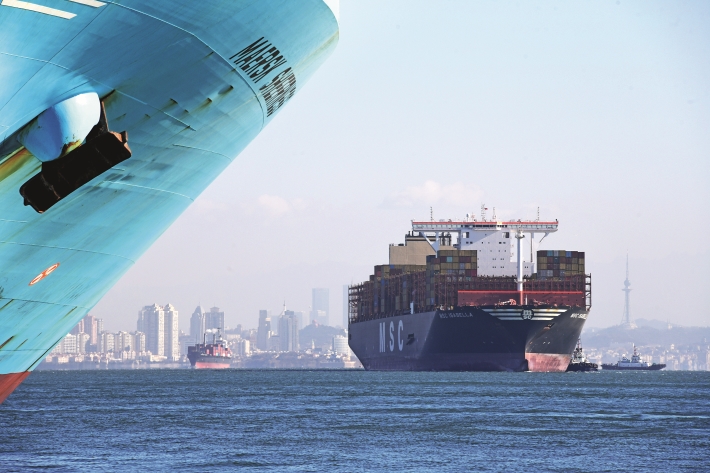|
||||||||||
| Home Top News Economy/Tech Culture/Sports China in Foreign Eyes Green Development Videos Intangible Cultural Heritages |
|
||||||||||
| Home Top News Economy/Tech Culture/Sports China in Foreign Eyes Green Development Videos Intangible Cultural Heritages |
| ChinAfrica |
| Connected Advantage |
| Interlinked supply chains are good for both China and the rest of the world |
| | VOL. 16 August 2024 ·2024-07-24 |

A cargo ship sails towards Qingdao Port in east China’s Shandong Province on 28 January 2023 (XINHUA)
As both a beneficiary of global supply chain integration and a contributor to the creation of a new supply chain ecosystem, China is of immense importance to the growth of international supply chains. For example, it’s manufacturing industry is indispensable across every stage of the global supply chain from raw material to intermediate goods production and the assembly of finished products. And with a large consumer base, China has been the place where global goods and services are consumed.
In the new era, will China’s supply and industrial chains gain new competitive edges? How will China continue to stabilise the supply chain? Three Chinese experts share their opinions on these questions.
A stabiliser for global supply chains
Wu Shengrong
Head, Department of Exhibition Management, China Council for the Promotion of International Trade
China has the capability to ensure the stability of supply and industrial chains for the following reasons.
First, China has continued to optimise its industrial system to better support global supply chains. It’s the only country in the world that has all the industrial categories in the UN industrial classification system. Its manufacturing industry has been the largest for 13 consecutive years, with an added value making up nearly 30 percent of the world total. High-speed railways, electrical equipment, construction machinery, and shipbuilding, among others, have become China’s global calling cards.
Second, China’s large market can boost the stability of global supply chains. With a population of 1.4 billion people, of which 400 million are in middle income group, China is no doubt the most promising market in the world. Devoted to the opening up policy, the country is the major trading partner of over 140 countries and regions, and has been the world’s second-largest importer for 14 straight years. Since 2023, the China Council for the Promotion of International Trade has hosted more than 100 executives of multinational companies who have all expressed their confidence with the Chinese market and promised greater investment. All these positive attitudes from foreign business leaders point to China’s increasing attraction for foreign investment.
Third, China’s efforts to promote the Belt and Road Initiative (BRI) will provide more opportunities for cooperation in the global supply chain. The BRI has become a well-recognised international public good, and a platform for cooperation. In the past decade, China has implemented numerous investment and cooperation projects in such fields like agriculture, energy, infrastructure, digital economy and new energy vehicles in participating countries of the BRI to fuel local industrial restructuring and supply chain optimisation.
Challenges faced by China’s industrial chain
Ni Hongfu
Researcher, Institute of Economics, Chinese Academy of Social Sciences
The development of China’s industrial chain may be hindered as the global supply chains face challenges in four aspects - limited growth potential, rising trade protectionism and anti-globalisation, geopolitical competition among world powers, and impacts from various aspects.
First, global supply chains are suffering growth bottlenecks, and their share in the trade in goods could not exceed 50 percent. After the global financial crisis in 2008, the investment in global supply chains and the breadth of supply chains has stopped growing. To fully tap the potential of global supply chains, incentives must be provided, such as reductions in trade costs and technological development. For this reason, deeper division of labour across supply chains will be impossible without further trade liberalisation and breakthroughs in technologies. Furthermore, weighed down by slower growth of supply-chain trade, global trade in goods has suffered a downturn, making its contribution to the world GDP languish at just 30 percent.
Second, rising protectionism and anti-globalisation have destabilised global supply chains. In recent years, trade protectionism and anti-globalisation movements have made a comeback, especially in Western countries where repulsion towards free trade and globalisation has spilled over to the government. Data shows as many as 223 trade and investment restrictions are introduced every year while merely 61 measures aimed at facilitating free trade are implemented worldwide.
Third, major-country rivalry and geopolitical conflicts have hindered the expansion of global supply chains. The disruption is visible in four aspects: (1) further development is hindered as the US government adjusts its foreign economic policies; (2) division of labour across the supply chain is negatively affected by the US’ export controls; (3) trade costs have gone up amid rounds of tariff increases by the US; and (4) corporate risks have risen due to the uncertainties about the China-US relationship.
Fourth, global supply chains are under impacts from various aspects. Global supply chains can be hit by natural disasters, logistics disruption, cyber-attacks, restricted power supply, labour shortage and other factors.

Two workers examine equipment parts at a plant in Jilin Province in northeast China on 29 April (XINHUA)
China’s supply and industrial chains gain new advantages
Xu Jianwei
Researcher, Institute of Industrial Economics and Technology Economics, Chinese Academy of Macroeconomic Research
With the acceleration of the new round of technological revolution and industrial evolution, as well as paradigm shifts in international division of labour and trade, global supply and industrial chains have undergone some changes. Against this backdrop, new advantages of China’s supply and industrial chains have begun to emerge.
The integrated development of sci-tech and the manufacturing industry will give China a competitive advantage in building industrial chains in emerging sectors. China has created an innovation-driven blueprint for emerging industries and industries of the future. Through combination of innovation and manufacturing, the country’s socioeconomic growth is expected to be amplified. New concepts like the Industrial Internet of Things, Industry 4.0 and Internet Plus reveal where China’s industrial and supply chains are heading and what advanced forms they might take. A full-fledged integration of manufacturing and technology has pushed China to the forefront in some emerging sectors such as new energy vehicles (NEVs). Driven by its efforts to meet dual carbon targets, China has taken a lead in developing green and low-carbon supply chains. To tackle the ever-worsening ecological degradation, countries all over the world have introduced their emission reduction goals and over 150 have promised to achieve carbon neutrality. China is not only an advocate of green and low-carbon development, but also has made breakthroughs in green technologies and promoted green transition of industries.
* These views are excerpted from CCTV, Economic Daily, and Study Times.
|
||||||||||||
| About Us | Contact Us | Advertise with Us | Subscribe |
| Copyright Beijing Review All rights reserved 京ICP备08005356号-5 京公网安备110102005860号 |